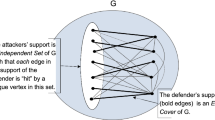Abstract
The paper aims at generalizing the notion of restricted game on a communication graph, introduced by Myerson. We consider communication graphs with weighted edges, and we define arbitrary ways of partitioning any subset of a graph, which we call correspondences. A particularly useful way to partition a graph is obtained by computing the strength of the graph. The strength of a graph is a measure introduced in graph theory to evaluate the resistance of networks under attacks, and it provides a natural partition of the graph (called the Gusfield correspondence) into resistant components. We perform a general study of the inheritance of superadditivity and convexity for the restricted game associated with a given correspondence. Our main result is to give for cycle-free graphs necessary and sufficient conditions for the inheritance of convexity of the restricted game associated with the Gusfield correspondence.







Similar content being viewed by others
Notes
\(\mathcal{F}\) is weakly union-closed if \(A \cup B \in\mathcal{F}\) for all A, \(B \in\mathcal{F}\) such that \(A \cap B \not= \emptyset\).
If A and \(B \in\mathcal{F}\) and if \(A \cap B \not= \emptyset\) then A∩B and A∪B are in \(\mathcal{F}\).
If A and B are in \(\mathcal{F}\) and if \(A \cap B \not= \emptyset\) then \(A \cup B \in\mathcal{F}\).
For all \(A \in\mathcal{F}\), the maximal subsets \(F \in\mathcal {F}(A)\) form a partition of A, and the singletons are in \(\mathcal {F}\).
References
Algaba, E., Bilbao, J. M., & Lopez, J. J. (2001). A unified approach to restricted games. Theory and Decision, 50(4), 333–345.
Aziz, H., Lachish, O., Paterson, M., & Savani, R. (2009). Wiretap** a hidden network. In Proceedings of the 5th international workshop on internet and network economics, WINE’09 (pp. 438–446). Berlin: Springer.
Borm, P., Owen, G., & Tijs, S. (1990). Values of points and arcs in communication situations (Technical report 9004). Dept of Mathematics, University of Nijmegen, The Netherlands.
Cunningham, W. H. (1985). Optimal attack and reinforcement of a network. Journal of the ACM, 32(3), 549–561.
Faigle, U. (1989). Cores of games with restricted cooperation. ZOR.Methods and Models of Operations Research, 33(6), 405–422.
Fonlupt, J., & Skoda, A. (2008). Strongly polynomial algorithm for the intersection of a line with a polymatroid. In Research trends in combinatorial optimization (pp. 69–85). Berlin: Springer.
Fujishige, S. (2005). Annals of discrete mathematics: Vol. 58. Submodular functions and optimization (2nd edn.). Amsterdam: Elsevier.
Grabisch, M. (2009). The core of games on ordered structures and graphs. 4OR: A Quarterly Journal of Operations Research, 7(3), 207–238.
Gusfield, D. (1991). Computing the strength of a graph. SIAM Journal on Computing, 20(4), 639–654.
Myerson, R. B. (1977). Graphs and cooperation in games. Mathematics of Operations Research, 2(3), 225–229.
Owen, G. (1986). Values of graph-restricted games. SIAM Journal on Algebraic and Discrete Methods, 7(2), 210–220.
Schrijver, A. (2003). Combinatorial optimization: polyhedra and efficiency. Berlin: Springer.
Skoda, A. (2009). A new algorithm for the intersection of a line with the independent set polytope of a matroid. Bulletin des Sciences Mathématiques, 133(2), 169–185.
van den Nouweland, A., & Borm, P. (1991). On the convexity of communication games. International Journal of Game Theory, 19(4), 421–430.
Acknowledgements
The authors wish to thank an anonymous referee, whose comments permitted to improve greatly the presentation of the paper.
Author information
Authors and Affiliations
Corresponding author
Appendix: Proof of Theorem 20
Appendix: Proof of Theorem 20
We give a direct proof following the method of van den Nouweland and Borm (1991).
Proof
For all A,B∈N such that A∩B=∅, we have v(A∪B)≥v(A)+v(B). Let us now consider A,B and i∈N such that A⊂B⊆N∖{i}. We have to prove \(\tilde{v}(A \cup\lbrace i \rbrace) - \tilde{v}(A) \leq\tilde{v}(B \cup\lbrace i \rbrace) - \tilde{v}(B)\). By definition, we have:
and
Let us denote by C(i) the unique maximal set \(C \in\mathcal{F}(A \cup\lbrace i \rbrace)\) such that i∈C. Let us denote by \(\mathcal{C}\) the family:
Observe that as i∉A, \(C(i) = \lbrace i \rbrace\cup(\bigcup_{C \in\mathcal{C}} C)\). (If \(C \in\mathcal{F}\), C⊂A∪{i}, C is maximal in \(\mathcal{F}(A \cup\lbrace i \rbrace)\) and i∉C, then C⊂A and C is maximal in \(\mathcal{F}(A)\).) Observe also that if \(C \in\mathcal{F}(A \cup\lbrace i \rbrace)\), C is maximal and \(C \not\subset C(i)\) then C∩C(i)=∅ (partition) and \(C \in\mathcal{F}(A)\) with C maximal in \(\mathcal{F}(A)\). Hence:
Analogously, we define D(i) as the maximal set D in \(\mathcal{F}(B \cup\lbrace i \rbrace)\) such that i∈D and:
Then \(D(i) = \lbrace i \rbrace\cup(\bigcup_{D \in\mathcal{D}} D)\) and:
Hence, it remains to prove that:
We want now to prove that for every \(C \in\mathcal{C}\), there exists one and only one \(D \in\mathcal{D}\) such that C=D. As A⊂B, A∪{i}⊂B∪{i} and therefore C(i)⊆D(i). Hence, for all \(C \in\mathcal{C}\), there exists precisely one \(D \in \mathcal{D}\) such that C⊆D. \(D \cap C(i) \not= \emptyset\) because \(D \cap C(i) \supset C \not= \emptyset\). D⊇C(i) contradicts i∉D. Therefore D⊂C(i). But i∉D and C(i)⊂A∪{i}, then D⊂A. But D is maximal in \(\mathcal{F}(B)\), hence D⊂A is maximal in \(\mathcal{F}(A)\). As C⊂D⊂A and C and D are maximal in \(\mathcal {F}(A)\), we have C=D. We can now number the elements of \(\mathcal{C}\) and \(\mathcal{D}\) in such a way that \(\mathcal{C} = \lbrace C_{1}, C_{2}, \ldots, C_{s} \rbrace\), \(\mathcal {D} = \lbrace D_{1}, D_{2}, \ldots, D_{t}\rbrace\) with s≤t and C r =D r for all r, 1≤r≤s. Superadditivity of the game (N,v) implies:
Then:
As D r =C r for all r, 1≤r≤s, we obtain:

That is precisely (57). □
Rights and permissions
About this article
Cite this article
Grabisch, M., Skoda, A. Games induced by the partitioning of a graph. Ann Oper Res 201, 229–249 (2012). https://doi.org/10.1007/s10479-012-1200-8
Published:
Issue Date:
DOI: https://doi.org/10.1007/s10479-012-1200-8




